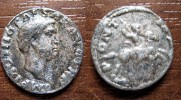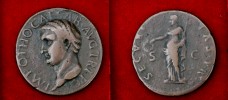
|
|
|
Domitianus denarii
|

|


|

|
My interest in Domitianus started when I read Ian Carradice's thesis from the early 1980s. One thing that caught my eye was the fact that on the basis of hoard evidence, he was able to show that certain denarius issues were very rare in comparison with others. This information was not reflected in the prices of these coins - most people would not care and very few actually knew. I kept hunting these unusual "trp/cos" combinations for years and with considerable success. The substantial collection I built turned out to be useful for silver content analyses as well as for the new edition of RIC II.i. After RIC II.i was published I felt the coins had served their purpose for me and the bulk of them have been dispersed. Many were sold though a few well-known dealers, the largest single collection, 40 rare issues, was obtained by the Ashmolean Museum, Oxford, UK. During the building of the collection many people helped me, but I want to thank one especially, Barry Murphy.
The fourth issue of year 85 CE is one of my favourites. It is recognized by TRP IIII on the obverse and CENS POT on the reverse. All four Minerva types and the Germania type should exist both with and without aegis. Minerva type 1 and the Germania type are not known without aegis but they will pop up one day. The two preceeding issues with CENSORIA POTESTAT and CENSORIA POTES had only portraits with aegis and the following issue with IMP V and CENS POT only portraits without aegis. A die-study would be interesting - did the dies cross the borders during this very short time and specially between the CENSORIA POTES and CENSORIA POT line, when the silver content was lowered?
50 files, last one added on Oct 30, 2012
Album viewed 56 times
|
|
|
|
|
|
|
|
|
Provincial Otho: Alexandria
|

|


|

|
According to RPC, five denominations were struck for Otho in Alexandria:
drachm
hemidrachm, two types
diobol, two types, both with two different legends
obol, two different legends
tetradrachm, five types, all with or without a simpulum on the reverse
The weights and sizes of the bronzes vary greatly and a heavy obol can be heavier than a light diobol and the lightest hemidrachms weigh less than the heaviest diobols. The types are quite different, however.
24 files, last one added on Jun 07, 2016
Album viewed 13 times
|
|
|
|
|
|
|
|

| Last additions - jmuona's Gallery |

This "Otho" with "VÍCTORIA PR" reverse is an ingenious fabrication created by the famous forger "Tardani". He had obviously realized that there were a few VICTORIA OTHONIS dies recut from Galba's VICTORIA PR dies and created this fictitious but possible coin with copies of real dies. I used to have this coin and another with the same dies is in the Berlin coin cabinet. Both are overweight, around 3.9 gr. It took some time to find a Galba minted with this particular reverse die but finally I succeeded. The final proof is seen in this coin, there are a few regions were the die has broken, ie before the die ever could have been used for an Otho coin. The coin is quite convincing because of the dies, but the surfaces were a bit strange and the legends unusual in profile.jmuonaApr 05, 2018
|
|

RIC 8 replicaCast replica based on real dies, offered as a gift to ?businesspeople and including "authentication" for the replica's quality by an offical source.jmuonaJun 07, 2016
|
|

RIC 8 replicaThis box contained the three replicas: Galba, Otho, Vitellius-jmuonaJun 07, 2016
|
|

Third_RIC 22jmuonaJun 07, 2016
|
|

RPC5370Obol, long obverse legend. RPC lists one coin.jmuonaJun 07, 2016
|
|

RIC 22 Modern fakeI have chosen to call this a Modern fake, although I believe it to be from the late 1800s. Fakes with the same obverse or an obverse very similar to this exist both in gold and silver. There are other examples in my gallery as well.jmuonaJun 07, 2016
|
|

RIC 8 Ancient counterfeitThis type with a smile never seen in a genuine coin is known from many collections. e.g. Paris.jmuonaJun 07, 2016
|
|

RIC 16 Ancient counterfeitConsidering how uncommon this type is as a genuine Rome mint product, the plated ones are really surprisingly frequent.jmuonaJun 07, 2016
|
|

RIC 16 Ancient counterfeitYet another counterfeit of this type. Plated and if intact, this would be quite convincing even today.jmuonaJun 07, 2016
|
|

Third_RIC 22Five different dies with Otho on horseback (RIC 22) are known. Two of them I have included as separate coins in this gallery, the three remaining ones are united in one image here. The die on the right is known from a single coin. jmuonaApr 11, 2013
|
|

First_RIC 8Although there appears to be nothing unusual about this coin, closer inspection reveals it is very unusual. The change in hair-do was abrupt between the IMP M and IMP obverses, but a couple of dies have survived with the old, long obverse inscription and the late hair-do with no free-flying locks present anymore. This is the least rare of them, a few coins minted with this distinctive obverse die are known.jmuonaMar 14, 2013
|
|

Otho-Vespasian muleThis coin I failed to obtain, but I suspect it may be an authentic Ancient counterfeit combining a Second/Third period Otho obverse with a Vespasian reverse. Said to have been found in UK by a detectorist. Very interesting. UPDATE: another coin combining a similar type of obverse and Domitian as Caesar reverse was sold on ebay recently. It is definitely more suspicious and I regard it as a modern forgery. This coin may be of same stock as well.jmuonaMar 13, 2013
|
|

| Random files - jmuona's Gallery |
|
|

Third_RIC 22Five dies of the Otho on horseback reverse are known. I have been fortunate to obtain them all. This one - also used for the previous coin - is the one seen most often. jmuona
|
|

Fantasy sestertius20.51 gr, max 33 mm, die-axis 6.jmuona
|
|

|
